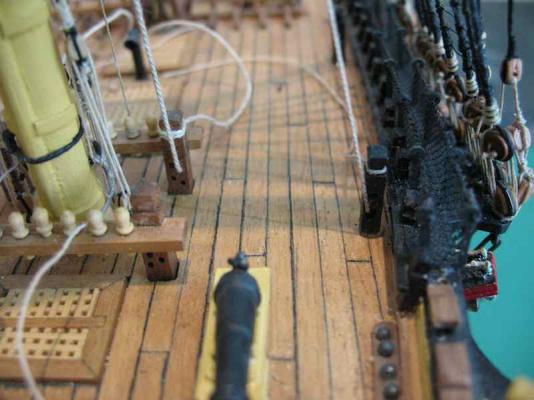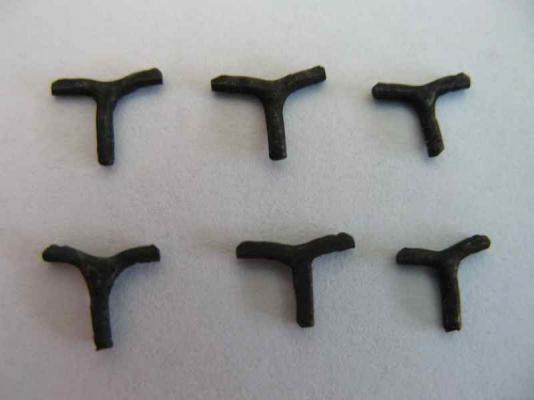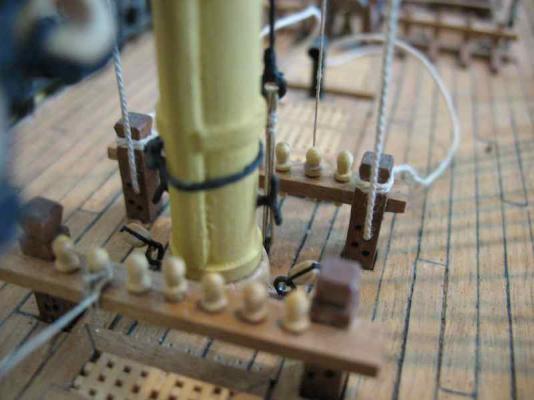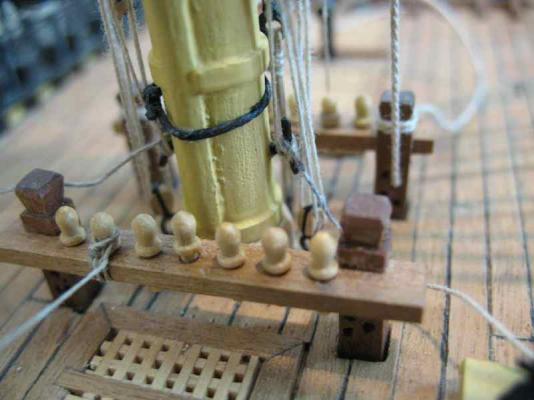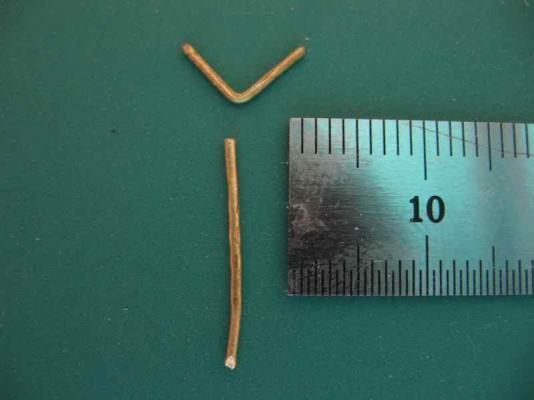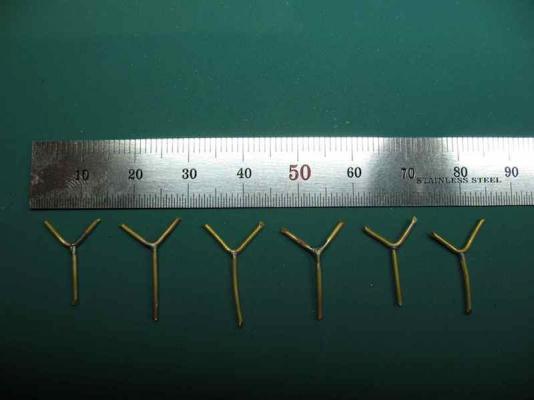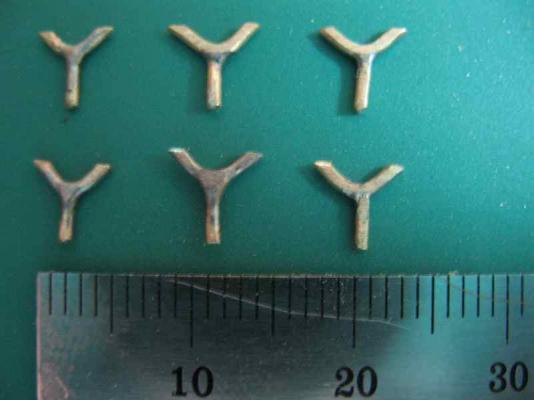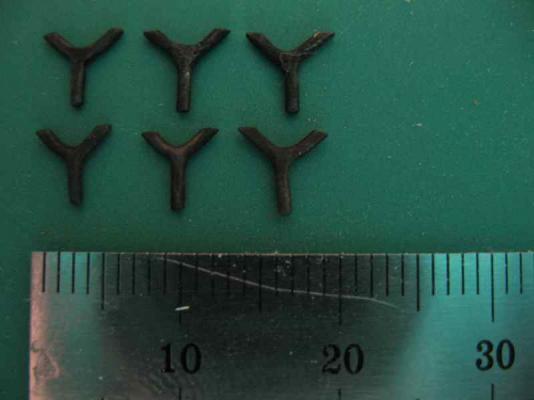-
Posts
4,891 -
Joined
-
Last visited
Content Type
Profiles
Forums
Gallery
Events
Everything posted by gjdale
-
I agree with Jim, Craig. The kit contents list should tell you how many stock strips of each dimesion, which is what you need to check for inventory. When it comes to cutting smaller pieces, always use the shortest available stock of that dimension and wood type that will do the job. That should ensure that you don't run out.
-
Fantastic work, as always Gil. It's really handy having you just that little bit further ahead of me so that I can start to think about what's next while having your pictures to assist that contemplation. I'm afraid that boarding pikes are one detail that my build will not be getting. Thanks again for your conversation and assistance on shroud trucks, shroud cleats and mast cleats. I am now quite satisfied with the way mine have turned out and they wouldn't even be there were it not for your assistance in the first place.
- 755 replies
-
- finished
- caldercraft
-
(and 1 more)
Tagged with:
-
Of course you use them Derek - otherwise your grandson will think you don't like them! Sorry to hear of the oops with bowsprit again. The further we go with the rigging, the more careful it seems we need to be. Nearly poked my eye out on the fore yard today - thank goodness for the Optivisor, which saved me (several times).
-
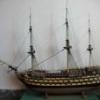
Victory by mikec - FINISHED - Mamoli
gjdale replied to mikec's topic in - Kit build logs for subjects built from 1751 - 1800
Your little launch is turning out very nicely Mike. Hope you don't get too distracted by the 1:1 project! -
Thanks again for all the nice comments and "likes". Daniel (Dafi) - thanks for the unashamed sales pitch, but I don't think I'll be needing your product. A small update...... Following the advice/opinions of you good folks, I made a minor tweak to the Mast Cleats prior to installation, which required re-blackening as well (no prob ) And here are the Foremast set installed (Main and Mizzen Mast Cleats have also been installed): And with the Truss Pendant falls re-done to belay on the Mast Cleats: This shot shows the forward Kevel Cleats (with working sheave) installed, with the Fore Yard Lifts belayed to them. (The Kevel is on the right of the photo, next to the bulwark): And finally, those pesky Shroud Cleats. I've finished installing the Foremast Shroud Cleats. Fortunately, the Main Mast Shrouds don't use any Shroud Cleats. So, just the Mizzen Shroud Cleats left to install. The only real difficulty in installing the Foremast Shroud Cleats was the fact that the Foremast Yard was already in place, causing a "poke your eye out" hazard (the optivisor saved me several times). The Mizzen ones should be a little easier to do. Taking a photo of the installed Shroud Cleats also proved problematic. This is about the best I could do in that regard. All in all, I'm pretty happy with the way both of these cleat sets have turned out.
-
I think it's just Nature's way of telling you to wait for the Amati/Chris Watton version to be released!
-
Mobbsie, I found your inner better modeller! He's been over on my log, sending me around the buoy several times! (for which, I might add, I am most grateful).
- 1,279 replies
-
- agamemnon
- caldercraft
-
(and 1 more)
Tagged with:
-
How wonderful to see you back working in the shipyard Anja! :) I'm with Mark - mistakes? Pfffffffffff (my only word of Dutch)!
-
Hi Craig, Congrats on starting your first build log. I'm sure you'll get plenty of help and advice with this one as there are a few of these being built here. I'm always interested in watching a paddle steamer come together - one of these is on my "one day" list - so I'll follow along for the ride. Jim, would you pass the popcorn please?
-

ROYAL CAROLINE 1749 by Doris - 1:40 - CARD
gjdale replied to DORIS's topic in - Build logs for subjects built 1501 - 1750
Stunning work as always Doris. I love the way all of your figures are made resembling friends and family - what a lovely personal touch!- 883 replies
-
- royal caroline
- ship of the line
-
(and 1 more)
Tagged with:
-
Fantastic looking coppering job there Bob. Love your technique too.
- 1,477 replies
-
- essex
- model shipways
-
(and 1 more)
Tagged with:
-
Great ideas on display Bug - we're going through that exact conversation in my house right now! It's probably going to result in some fairly costly "negotiated" room modifications Love the idea of being able to embarrass the hell out of your teenage children - call it "parents' revenge"!
- 274 replies
-
- Santa Maria
- Artesania Latina
-
(and 2 more)
Tagged with:
-
Hi Mobbsie, Great work so far mate. A pity about having to re-do the shrouds/dead-eyes, but better to find out now rather than later on! Looking forward to more pics.
- 1,279 replies
-
- agamemnon
- caldercraft
-
(and 1 more)
Tagged with:
-
Thanks everyone for the comments and "likes" - all very much appreciated. Danny - I used Costello boxwood. I didn't want to dip into my very limited supply of English Box for this job, especially as it was partially experimental. Bug - I get all my timber from HobbyMill these days, though you won't get any English Box there. For that you will need a balaclava and a baseball bat, and the address of someone who has some stashed away! Seriously though, English box is pretty hard to come by and I understand quite expensive when you can get it. Very happy for someone to tell me I'm wrong on this though.
-
Thanks guys - a small tweak with the pliers just prior to fitting the mast cleats it shall be then. I really appreciate the input folks - constructive criticism really helps to achieve the best possible outcome. Thanks for keeping me "honest". B.E. - silver soldering is not at all difficult. I'm still quite a novice, but seem able to get by to meet my needs. There is a good tutorial in the downloads section of the site. With your evident abundant skill set, I expect you will master it in no time at all.
-
Thanks Lawrence and Augie, and the "likes". I think even Mobbsie will be satisfied with this version! I've been pondering the Mast Cleats as well over the last few days and came to the conclusion that making wooden ones just wasn't going to do it - they would either be too large/chunky or too fragile. So I got an idea from B.E.'s Pegasus log, where he had made some brass cleats from eyebolts. That got me to thinking in terms of brass, and eventually I hit on the idea of making them in two parts (one for the "stem" to mount into the mast, and one for the "horns") and silver soldering them together. So that's what I did...... Starting with some 1mm diameter brass wire, and cutting two pieces, with one bent at a right angle. I deliberately made each part extra long to make it easier to handle. Then a quick visit to the garage and a few minutes with the silver solder paste and mini torch: Then cleaned them up with a file and cut each leg of the "Y" to size: And finally, chemically blackened using Casey Birchwood Brass Black (thanks Danny for putting me on to that stuff! ): Now, unless Mobbsie sends me around the buoy on this one, I think these are ready for installation.
-
Thanks Robert and B.E. - your votes of confidence are much appreciated.looks like we have a winner.
About us
Modelshipworld - Advancing Ship Modeling through Research
SSL Secured
Your security is important for us so this Website is SSL-Secured
NRG Mailing Address
Nautical Research Guild
237 South Lincoln Street
Westmont IL, 60559-1917
Model Ship World ® and the MSW logo are Registered Trademarks, and belong to the Nautical Research Guild (United States Patent and Trademark Office: No. 6,929,264 & No. 6,929,274, registered Dec. 20, 2022)
Helpful Links
About the NRG
If you enjoy building ship models that are historically accurate as well as beautiful, then The Nautical Research Guild (NRG) is just right for you.
The Guild is a non-profit educational organization whose mission is to “Advance Ship Modeling Through Research”. We provide support to our members in their efforts to raise the quality of their model ships.
The Nautical Research Guild has published our world-renowned quarterly magazine, The Nautical Research Journal, since 1955. The pages of the Journal are full of articles by accomplished ship modelers who show you how they create those exquisite details on their models, and by maritime historians who show you the correct details to build. The Journal is available in both print and digital editions. Go to the NRG web site (www.thenrg.org) to download a complimentary digital copy of the Journal. The NRG also publishes plan sets, books and compilations of back issues of the Journal and the former Ships in Scale and Model Ship Builder magazines.



